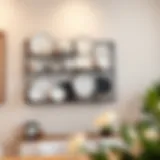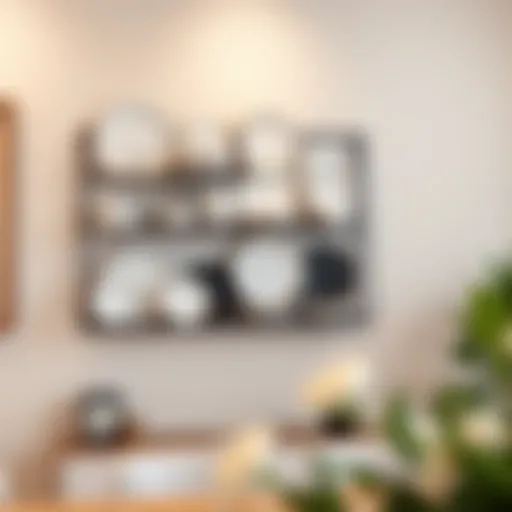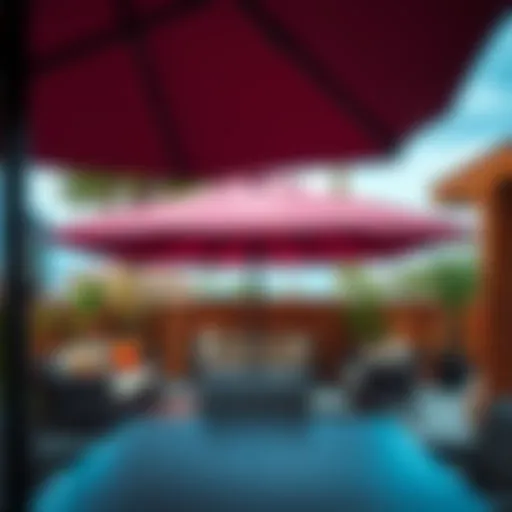The Modern Trash Can: Style Meets Functionality


Intro
In today’s world, who would’ve thought that a trash can could be a focal point in our homes? Gone are the days when these containers stood in the corner, camouflaged by ordinary looks and basic functions. Today’s trash cans not only serve the purpose of waste disposal but are art pieces in their own right. As we navigate the evolving design landscape, understanding the significance of these containers helps in making informed decisions on their selection and placement in our personal spaces.
This article will illuminate the different styles and trends in modern trash cans while equally highlighting their utility. Homeowners, designers, and DIY enthusiasts alike will find themselves immersed in the analysis of various materials, colors, and functionalities. Furthermore, we aim to incorporate a discussion surrounding sustainable practices that serve both our aesthetic sensibilities and environmental responsibilities.
Furniture Styles and Trends
As the realms of interior design continue to expand, so do the styles of trash cans which blend seamlessly into contemporary decors. It is crucial to recognize how modern trash cans fit into broader furniture trends to appreciate their importance in current setups.
Modern vs. Traditional: Understanding the Aesthetics
At the heart of furniture design lies the eternal struggle between modern ideals and traditional aesthetics. Modern trash cans, featuring crisp lines and minimalistic elements, cater to the needs of sleek urban environments. Materials like stainless steel or polished plastic create a clean appeal, easy to integrate in settings ranging from industrial lofts to modern suburban homes. On the flip side, traditional designs favor the ornate and the classic, perhaps wood or ceramic constructions that evoke a sense of nostalgia. The challenge is finding a balance that resonates with one's personal style while still serving a practical function.
Selecting between these styles involves considering how the trash can aligns with the rest of the decor. As more individuals lean toward open-plan spaces, choosing a trash can that does not hinder the visual flow becomes paramount. After all, in a room with understated elegance, a gaudy trash bin can certainly disrupt the entire vibe.
Color and Material Trends: What's In and What's Out
When it comes to color and materials
- Metals: Stainless steel remains a staple; its durability and sleek look are hard to beat. 😏 On the downside, finger smudges can become a constant headache.
- Bamboo: This eco-friendly option has found its way into modern styles. Its natural warmth offers a lovely contrast in a cold environment, although it may require a wee bit more upkeep.
- Plastic: While a common choice, boring colors are out. Instead, bold shades like neon green or pastel blues are in, lending personality to functionality.
What’s become crystal clear in the current design landscape?
- Neutral colors continue to trend for those who prefer understated elegance, while daring hues attract attention and inject an element of surprise.
- Irregular shapes—think geometrical madness—are gaining traction as well, transforming trash cans into unexpected design pieces that beg for a double-take.
Striking the right chord between aesthetics and utility helps create a cohesive environment that resonates with guests, inviting a deeper appreciation of each chosen piece, trash can included.
“Functional design doesn’t need to be boring; it should reflect personality and purpose in equal measure.”
This evolving conversation around trash cans exemplifies how a simple necessity can amplify the beauty of a space while meeting our modern needs for sustainability and style.
Preface to Contemporary Trash Cans
In today’s world, where aesthetics and functionality are paramount, trash cans have emerged as more than mere receptacles for waste. The evolution of these everyday items has taken them from basic disposable bins to significant components in both home design and environmental sustainability. Understanding contemporary trash cans involves exploring how they adapt to modern lifestyles, influence decor choices, and meet the heightened expectations of consumers. This analysis is crucial for homeowners, designers, and retailers alike, as it illuminates not just the practical aspects of these bins but also their cultural and stylistic roles in our living spaces.
The Traditional vs. The Modern Trash Can
Traditionally, trash cans were often an afterthought, designed solely for functionality. From the simple metal buckets to the ubiquitous plastic containers, their primary purpose was waste disposal, lacking finesse or attention to detail. However, modern trash cans have undergone a transformative redesign, incorporating features that blend seamlessly with interior trends while maintaining exceptional performance.
- Materials: Unlike the early days of metal or cheap plastic, modern options boast stainless steel, bamboo, or even recycled materials, appealing to eco-conscious consumers.
- Design: Where traditional bins often featured bland, utilitarian shapes, today’s trash cans come in a variety of elegant forms, colors, and styles that complement any decor—be it minimalist or colorful.
- Functionality: Many now include advanced features like foot pedals, motion sensors, and compacting capabilities, enhancing their usability dramatically.
The stark contrast between historical and contemporary designs comes down to user experience. A modern trash can isn’t just about hiding garbage; it’s an integral part of maintaining an organized and stylish environment.
Cultural Significance of Trash Cans
Trash cans may appear to be mundane objects, yet they carry a wealth of cultural significance. Throughout history, the symbolism of waste disposal reflects attitudes towards consumption, cleanliness, and societal norms. The evolution of trash cans mirrors our changing values regarding waste management and environmental awareness.
- Reflection of Values: In many ways, the design of trash cans today aligns with a growing societal emphasis on sustainability. Bins incorporating composting features or made from recycled materials signify a shift towards eco-friendly practices.
- Art and Design Influences: Renowned designers have taken notice of disposable products. Collaborations with artists have led to makeshift installations that explore deeper themes of waste and beauty. For example, the artistic aesthetics of a trash receptacle can provoke thought on consumerism and its effects on the environment.
- Public Spaces Impact: In urban areas, the design of public trash cans influences how communities perceive cleanliness and maintenance. A well-designed trash can in a park or public square may encourage proper disposal and foster pride in the community.
Design Elements of Cool Trash Cans
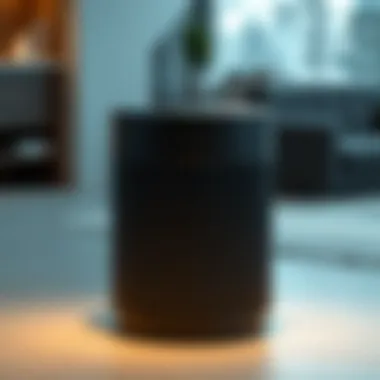

When it comes to modern design, even the most mundane objects have a part to play. Trash cans, often overlooked, deserve a spot in both functionality and aesthetics within contemporary spaces. Their design elements can enhance not just the room's look but also the efficiency of waste management. By understanding the various components that make a trash can appealing and practical, homeowners and designers alike can elevate their interior game.
Material Choices
The material a trash can is made from is fundamental to its durability and appearance. Options range from classic plastics to sophisticated metals and eco-friendly materials. For instance, stainless steel offers a sleek finish that can withstand rust and stains, making it an ideal choice for kitchens. On the other hand, biodegradable materials appeal to the environmentally conscious, merging style with sustainability.
- Plastic: Lightweight, affordable, and available in a myriad of designs and colors. Perfect for casual settings but may lack longevity.
- Metal: Options like aluminum or stainless steel not only provide a modern look but also add to the robustness of the design.
- Bamboo or Recycled Fibers: These options bring a unique touch and support eco-friendliness, appealing to those who want their decor choices to reflect a green lifestyle.
When choosing material, consider where the trash can will live and how it will interact with the surrounding decor. A wood finish might complement rustic themes, while polished metals fit perfectly in a minimalist or industrial setting.
Color and Aesthetic Appeal
Color isn’t merely decorative; it influences mood and complements the overall decor. A bold, bright red can energize a space, while soft pastels create a calming effect. Trash cans now come in an array of shades and finishes, allowing homeowners to match them precisely with their space.
- Neutral Colors: These are versatile and blend well with various designs, often enhancing a minimalist aesthetic.
- Bold Colors: Perfect for making a statement, they can serve as a focal point in a room that might otherwise feel drab.
- Patterns and Textures: Some trash cans incorporate patterns that contribute to the overall theme, whether it's modern, bohemian, or art deco.
In essence, a trash can can no longer be just functional; it must integrate smoothly into the design language of the home, acting as a seamless part of the decor rather than an afterthought.
Size and Capacity Considerations
When selecting a trash can, size and capacity shouldn't be taken lightly. It's crucial to assess how much waste you typically generate and what space you have available. A stylish can is useless if it cannot accommodate your waste needs or if it overwhelms a smaller space.
- Small Spaces: Compact designs fit snugly in tight spots, perfect for apartments or smaller rooms.
- Family Homes: Larger capacities help in managing more waste, minimizing frequent disposal visits.
- Adjustable Sizes: Some innovative designs allow for the size to change, making adaptability a key feature.
Always remember that function and design must go hand-in-hand. After all, a trash can that can't hold your daily refuse runs the risk of becoming an eyesore and an inconvenience. By carefully considering materials, color, and size, you can find a trash can that isn't just a functional need, but rather a stylish addition to your living space.
Functionality and Technology in Trash Cans
When it comes to modern trash cans, functionality and technology are not just nice-to-have features; they have become essential components that define the very nature of waste management in today’s homes. As we evolve in our understanding of sustainability and convenience, it’s clear that a trash can's role has expanded beyond simply holding refuse:
- Ease of Use: The introduction of innovative technology makes waste disposal more user-friendly, allowing homeowners to maintain cleanliness with minimal effort.
- Space Optimization: Today’s designs maximize utility without compromising aesthetic appeal, fitting seamlessly into various environments—whether that’s a compact apartment kitchen or a spacious outdoor patio.
- Efficiency in Waste Management: Integrating advanced features into trash cans helps reduce waste volume, assists in recycling efforts, and ultimately supports broader environmental goals.
Sensor Technology in Waste Disposal
Modern trash cans equipped with sensor technology have revolutionized how we manage our waste. With just a wave of the hand, these cans become operational, offering significant advantages:
- Hands-Free Operation: The primary appeal lies in their hands-free opening mechanism. This feature is particularly beneficial in kitchens where preparing meals involves sticky hands. Imagine chopping vegetables and simply waving to dispose of scraps without touching the can at all.
- Hygienic Solutions: Sensor trash cans help keep germs at bay. For instance, brands such as simplehuman and iTouchless have developed models that feature touchless functionality combined with anti-microbial plastic, reducing the spread of bacteria—ideal for family spaces.
- Auto-Close Mechanism: Many models incorporate an automatic close function that not only preserves the smell by sealing the bag but also ensures that the bin looks polished at all times.
In essence, choosing a trash can with sensor technology is both a lifestyle enhancement and a nod towards healthier living environments.
Compaction Features and Sustainability
The shift toward eco-friendly practices has also influenced the design and engineering of trash cans. Compaction technology helps homeowners manage waste more efficiently by reducing the volume of garbage:
- Space Efficiency: Compact models can squash refuse down to a third of its size, meaning fewer trips to the curb each week. This is not only good for urban dwellers who may have limited space but also contributes to convenience and efficiency in waste management.
- Environmental Impact: By using a compaction trash can, the overall carbon footprint can be reduced. Less frequent garbage collection results in lower fuel usage for collection vehicles. Additionally, compacting materials like plastic or cardboard helps encourage recycling, as it can be sorted more easily when contained in manageable sizes.
- Smart Integration: Some compaction cans are paired with smart technology, alerting users when they are full and thus eliminating guesswork. This feature can be complemented with eco-friendly bags that are biodegradable, enhancing their sustainability quotient.
"The integration of functionality and advanced technology into trash cans highlights a broader shift in consumer expectations towards efficiency and environmental responsibility."
In sum, functionality and technology in trash cans are no longer just afterthoughts. They are pivotal in shaping our waste management processes, driving us towards a cleaner future while ensuring our living spaces remain aesthetically pleasing. By embracing these advancements, we position trash cans not merely as utility objects but as integral components of modern home design.
Integration into Home Decor
In today's world, where aesthetics and functionality often go hand in hand, integrating trash cans into home decor is no small feat. A trash can is no longer just a receptacle for waste; it’s a critical element of design that can enhance or detract from the overall look and feel of a space. By choosing the right trash can, homeowners can elevate their interiors, showcasing personal style while still addressing the practical need for waste disposal.
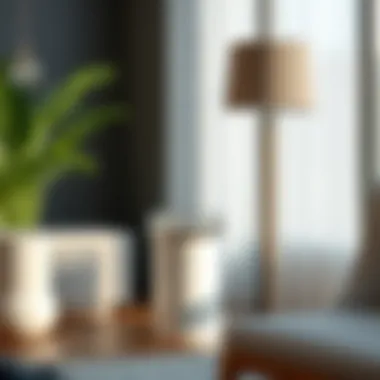

Choosing the Right Style for Your Space
When selecting a trash can, it’s crucial to consider the accompanying elements of your decor. The right style serves as a visual anchor and can either complement or stand out in a significant way. For instance, if you're rocking a rustic farmhouse vibe, a wooden trash can with a vintage finish might resonate perfectly with your aesthetic. On the flip side, if minimalism is your game, sleek stainless steel or even a matte-black finish can blend seamlessly without overstaying its welcome.
Factors to consider include:
- Color and Texture: Match your trash can’s color with your wall paint or surrounding furniture. A splash of vibrant hue can turn an ordinary item into a focal point.
- Shape and Size: A tall and slender design fits comfortably in tight spaces, while a robust, wide option might suit a kitchen island or a corner that needs softening.
- Theme Cohesiveness: Ensure that whatever choice you make aligns with the broader theme of your home. It should feel like it belongs there, not like an afterthought thrown in for necessity.
Placement Strategies for Optimal Functionality
The strategic placement of a trash can can make a world of difference in its usability and the overall flow of your space. Thoughtfully positioning your trash receptacle could stave off clutter and unwanted odors while promoting easy access.
Here are some effective strategies:
- High Traffic Areas: Place a trash can in areas of frequent use, such as the kitchen or the living room. This encourages immediate disposal of waste and keeps surfaces tidy.
- Near Garbage Sources: Placing a bin close to areas where waste is generated, like the dining table or home office, can simplify clean-up and reduce the chance of waste ending up on the floor.
- Aesthetically Pleasing Corners: Sometimes, a trash can can serve other purposes. A decorative model might sit pleasingly in the corner of a room, subtly blending in without calling too much attention to itself, yet remaining within reach.
- Avoid Hidden Spots: While it’s tempting to tuck bins away into closets or cabinets, this can lead to a build-up of waste. Instead, visible yet discrete placements encourage regular usage and maintenance.
- Consider under-counter models that can slide out easily when needed, especially in smaller kitchens.
- A dual-compartment style could promote both recycling and composting in one spot, enhancing eco-friendly practices.
Choosing the right style and strategically placing your modern trash can not only enhances utility but also contributes to a cleaner, more visually appealing household. The art of incorporating these essential items into your home should not be underestimated; it plays a significant role in how we interact with our living spaces each day.
Sustainability and Eco-Friendly Options
In today's evolving consumer landscape, the push for sustainability and eco-friendliness has permeated every facet of design, including one often-overlooked component: trash cans. The modern homeowner is increasingly aware of the environmental impacts of their purchases, leading to a demand for products that not only serve a functional purpose but also align with sustainable practices. Thus, trash cans are no longer mere receptacles for waste; they are reflections of our commitment to the environment and our efforts to embody responsible living. By choosing eco-friendly options, consumers contribute to a larger conversation about sustainability in product design.
Composting Models
Composting models have gained traction in recent years as a practical solution for reducing household waste. These specialized trash cans feature compartments that facilitate the breakdown of organic materials, transforming food scraps and yard waste into nutrient-rich compost. This process minimizes landfill contribution and enhances soil health, aligning perfectly with sustainable gardening practices.
Benefits of composting models include:
- Reduction of Landfill Waste: By diverting organic materials, these models significantly lessen the amount of waste that ends up in landfills.
- Rich Nutrients for Gardening: Compost produced can be used to enrich gardens, promoting plant health and yielding better crops.
- Odor Control: Many composting cans come equipped with air-tight lids or ventilation systems to prevent unpleasant smells, making them suitable for indoor use.
While integrating a composting model requires some initial education on what can and cannot be composted, the environmental payoff makes it a wise investment for eco-conscious households. Far from a mundane object, these trash cans become essential tools in fostering sustainable living.
Recyclable Materials in Trash Can Production
Increased attention to the materials used in production has led to the emergence of trash cans made from recyclable materials. Utilizing products such as recycled plastics or metals, manufacturers are creating options that lessen the ecological footprint of the production process. Through this thoughtful choice, consumers support a circular economy—one where materials are reused, helping to reduce raw material extraction and waste.
Key considerations in this area include:
- Durability and Quality: Recyclable doesn’t mean flimsy. Many brands prioritize robust construction even when using repurposed materials, ensuring the trash can lasts longer.
- Aesthetic Versatility: Eco-friendly trash cans made from recycled materials often come in a range of appealing designs and finishes, suitable for diverse home decors.
- Support for Sustainable Brands: Choosing these trash cans allows consumers to support companies committed to sustainability, fostering awareness and demand for greener practices.
"By choosing recyclable materials, we not only foster environmental stewardship but also inspire innovation in product design."
Integrating sustainability into the consumer's life is not merely a trend; it is a compelling necessity. Understanding the role of trash cans within this framework reveals deeper insights into our relationship with waste and design, making every choice impactful.
Trends Shaping the Future of Trash Cans
As the world continues to embrace sustainability and smart living, trash cans are evolving beyond their basic function. It's fascinating how these once humble objects are now at the forefront of home design, merging practicality with aesthetic appeal. Recognizing the pivotal trends that shape the future of trash cans not only informs consumers but also influences manufacturers and designers, stirring innovation in a market that was once considered dull and utilitarian.
Smart Trash Solutions
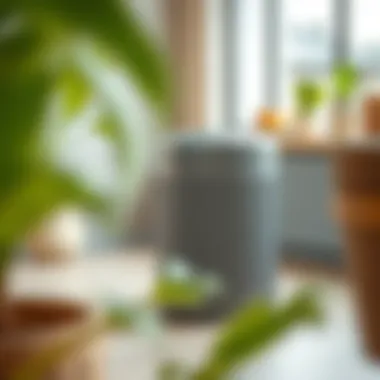

The rise of smart home technology has spilled over into the waste management sphere. Nowadays, smart trash cans come equipped with features that significantly enhance user experience. These cans can be activated with voice commands, or motion sensors, or even connected to smartphone applications. Imagine a world where your trash can reminds you when it’s full, provides data on waste disposal habits, or even suggests best recycling practices. Such innovations are not just gimmicks; they can lead to more efficient waste management and environmental consciousness in households.
- Many models include compaction technology, allowing for more waste storage without taking up extra space.
- Some smart cans provide separate compartments for recyclables, making sorting second nature.
- The integration of biodegradable sensor materials also represents a commitment to eco-friendliness, enhancing the overall sustainability of these products.
With these advancements, it's clear that the consumer's expectation is shifting toward more interactive and responsible waste management solutions.
Design Influences from Minimalism
Minimalism is not just a trend; it's a philosophy that resonates throughout home decor, including trash can designs. Homeowners gravitate toward simplicity, favoring clean lines and muted colors over ornate embellishments. This shift promotes functionality without sacrificing aesthetics. A minimalist trash can becomes more than a receptacle; it serves as an understated design choice that melds seamlessly into a modern interior.
When selecting a trash can, consider these minimalist design features:
- Sleek materials: Stainless steel and matte finishes are prevalent, presenting a contemporary look.
- Neutral color palettes: White, grey, and black remain popular, providing versatility across various decor themes.
- Streamlined forms: Round or square shapes with an uncluttered appearance appeal to the modern eye.
These elements ensure that the trash can complements the surrounding environment, providing not just a decorative solution, but an extension of the homeowner's personal style.
The aesthetic preference toward minimalism highlights the importance of design in every aspect of life, including functional objects like trash cans — making them relevant to today’s design enthusiasts.
Consumer Insights and Preferences
Understanding consumer insights and preferences is like peering into the soul of a market. It reveals not only what people want but also why they lean toward certain products over others. In the context of modern trash cans, this knowledge is pivotal for manufacturers and retailers aiming to meet the evolving demands of contemporary consumers. Today’s buyers don't simply look for a receptacle to toss their waste; they seek a blend of high function and aesthetic appeal, making their choice an extension of their personal style and values.
Understanding Buyer Motivations
Buyer motivations can be as diverse as a box of chocolates—each individual has distinct tastes and preferences. The motivations behind choosing a modern trash can can be categorized into several key areas:
- Aesthetic Appeal: Many consumers consider the visual aspect of trash cans as essential. They often prefer designs that complement their home decor, which is why sleek finishes and unique shapes can be game-changers in the market. Buyers are more inclined to purchase a trash can that doesn’t look out of place in their stylish kitchen or trendy living space.
- Sustainability: Increasingly, people are prioritizing eco-friendliness in their purchasing decisions. When it comes to trash cans, many are interested in options that promote sustainability, whether through using recyclable materials or offering composting capabilities. This reflects a broader societal push towards environmental responsibility and conscientious living.
- Functionality and Convenience: A trash can that is easy to use, maintain, and empty showcases practicality. Features such as foot pedals, touchless sensors, and built-in odor control can drive purchasing decisions. Buyers often look for innovative solutions that make waste disposal less of a chore.
- Brand Reputation: Consumers tend to gravitate toward brands that resonate with their values or have earned their trust through quality and customer service. For many, a well-regarded brand that stands for sustainability or superior craftsmanship can tip the scales in favor of choosing one product over another.
Market Analysis of Innovative Trash Can Designs
A keen observation of the market reveals a tapestry of innovative designs reshaping how trash cans are perceived. Manufacturers are venturing beyond basic functionality to create products that capture imagination and cater to nuanced consumer preferences. Factors contributing to this market evolution include:
- Smart Technology Integration: Trash cans equipped with smart technology are trending. These include features like app connectivity, garbage tracking, and automatic separations of waste types. Such advanced options appeal to tech-savvy consumers looking for seamless incorporation of modern technology into their daily lives.
- Customizable Options: Some brands allow consumers to customize their trash cans, from size to color and even functionalities. This option can attract those who want a tailor-made solution that fits their specific needs and space.
- Focus on Minimalism: In line with broader design trends, minimalist designs have been gaining traction. Clean lines, muted colors, and simple shapes not only enhance the aesthetic appeal but also cater to clutter-conscious consumers who appreciate an understated look.
- Market Trends Towards Premium Products: There's a noticeable shift towards premium trash cans as homeowners consider them as investments rather than merely utilitarian objects. This shift presents opportunities for brands that can demonstrate the value and durability of their products through quality materials and innovative designs.
"In selecting a trash can, consumers are not just choosing a receptacle; they are making a lifestyle statement that pivots around elegance, innovation, and environmental awareness."
To sum it up, understanding consumer insights and preferences when it comes to trash cans is indispensable for anyone in the industry—from retailers to designers. By recognizing what motivates buyers, brands can strategize effectively, creating products that resonate with the target audience and stand out in the crowded marketplace. The aim of design, after all, is to meet the consumer where they are—bridging the gap between their needs and their tastes.
Finale: The Evolving Role of Trash Cans in Design
As we wind down this exploration into the world of trash cans, it becomes clear that these seemingly mundane objects hold greater significance in contemporary design than many might realize. Trash cans, once regarded solely as utilitarian items, now occupy a crucial role in blending form and function within our living spaces. This transformation reflects broader societal trends, where aesthetics and environmental consciousness increasingly influence consumer choices.
The modern trash can is no longer just about waste disposal; it has grown into an essential design element that complements and elevates home interiors. Homeowners today recognize that a stylish trash can can enhance the overall aesthetic of a room. No longer hidden away, these cans are often displayed prominently, making their design just as important as that of any chair or table. The availability of various materials, colors, and styles fuels a larger trend of personalization and customization in home decor.
Reflecting Societal Values Through Design Choices
In the current landscape, the choice of a trash can can serve as a reflection of a homeowner's values and lifestyle. For instance, opting for a sustainable, eco-friendly model indicates a commitment to environmental responsibility. Consumers are increasingly aware of the impact their choices have on the planet, leading to a demand for trash cans made from recycled materials or those designed to facilitate recycling and composting.
This shift in design philosophy goes beyond mere appearance. A trash can that showcases elegant design can inspire those around it to be more conscientious about waste. Those sleek stainless steel containers, geometric shapes, or even artistic touches to traditional designs present not just utility but also serve as a reminder to nurture an organized and responsible living atmosphere.
It’s important to consider that these choices also extend to the technology integrated into modern trash cans. Whether it’s smart sensors that help manage waste more effectively or built-in recycling compartments, these innovations not only improve the functional aspects of waste disposal but also emphasize the expectation that design can solve everyday challenges.
Moreover, the aesthetic appeal of trash cans has led to a rise in niche markets tailored toward interior decorators and design enthusiasts. Key trends include:
- Smart Technology: Trash cans equipped with sensors and smart features for ease of use.
- Minimalist Designs: Simple and clean lines that cater to modern space aesthetics.
- Artistic Elements: Collaborations with artists to create unique pieces that make a bold statement.
- Eco-Friendly Focus: Products designed with sustainability as a core principle, appealing to environmentally conscious consumers.
In summary, the evolution of the trash can from a humble receptacle to a sophisticated design item highlights how much our values influence our everyday choices. The modern trash can encapsulates a fusion of artistry, technology, and ethical considerations, seamlessly integrating into the tapestry of contemporary living spaces. As we continue to design our homes, it’s increasingly clear that even the simplest elements can reflect our aspirations, innovations, and consciousness.
"Design is not just what it looks like and feels like. Design is how it works." – Steve Jobs
By embracing this notion, we can better appreciate the evolving role of trash cans in our lives, recognizing the potential they have to inspire change and promote a more sustainable future.












